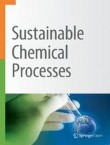Production of cellulosic ethanol from steam-exploded Eucalyptus urograndis and sugarcane bagasse at high total solids and low enzyme loadings
Cellulosic ethanol is one of the most important biotechnological products to mitigate the consumption of fossil fuels and to increase the use of renewable resources for fuels and chemicals. By performing this ...


























